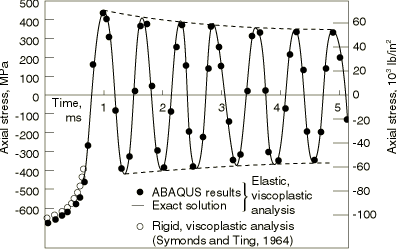The exact equation of motion for this system in terms of the stress, , in the rod, is
where E is Young's modulus, D and p are the viscoplastic parameters, is the static yield stress in uniaxial tension, A is the cross-sectional area of the rod, L is the length of the rod, m is the attached mass, and is 0 if ; is 1 if °.
The initial conditions on this equation are , where is the initial velocity given to the mass.
An accurate solution to this equation can be developed by standard numerical methods. In this case the fourth-order Runge-Kutta algorithm has been used, giving the stress-time plot shown in Figure 2. The rigid, viscoplastic analysis of Symonds and Ting (1964) and the solution obtained by Abaqus are also shown in the figure. The Abaqus plane stress results are identical to those obtained with the truss element. Fixed time stepping is used so that the numerical solution can be compared continuously with the exact solution. Three different time increment sizes are used to obtain the response details. These are 2.5 s, 10 s, and 25 s for the time periods 0–50 s, 50 s–0.1 ms, and 0.1–5 ms, respectively.
Figure 2 shows that the numerical solution accurately predicts the exact solution until the very end of the plot, when a small phase error begins to appear in the numerical solution.
It is interesting to see the form of the solution: in the first half-cycle the stress increases very rapidly to about 2.38 times the static yield, then unloads, slowly at first, then more rapidly. During this first half-cycle about 99% of the initial kinetic energy is dissipated in plastic work (this result is available by printing a summary of the total energy content to the data file). The remaining response analyzed (up to 5 ms) continues to have some dissipation at peak stress in each half-cycle. Since there is so little energy left in the system compared to the rod's ability to store strain energy, the resulting damping of the response amplitude in each cycle is not large. The rigid, viscoplastic solution of Symonds and Ting (1964) follows the elastic, viscoplastic curves accurately because the initial energy is so large compared to the strain energy that can be stored. The rigid, viscoplastic solution estimates a final strain of 6.75% in the rod. The numerical analysis shows a total plastic strain of 6.59% at 0.7 ms, with still some slight increase of this value during each half-cycle, as the peak stress continues to exceed static yield.


